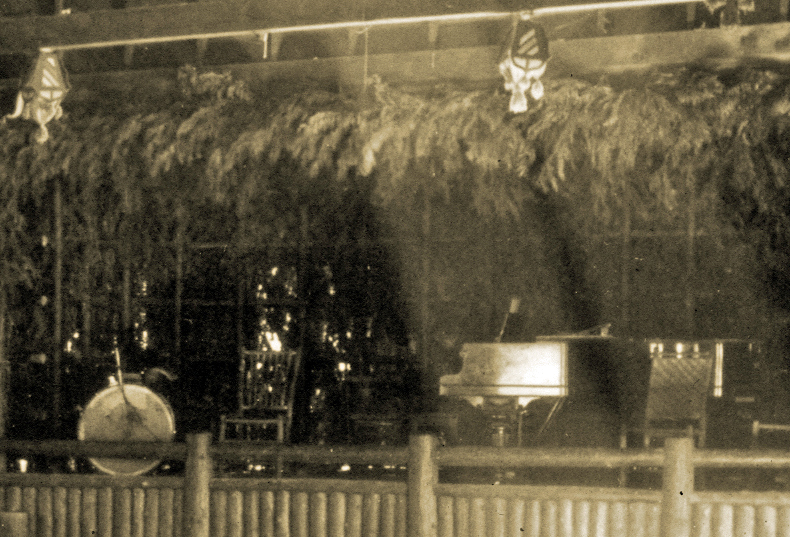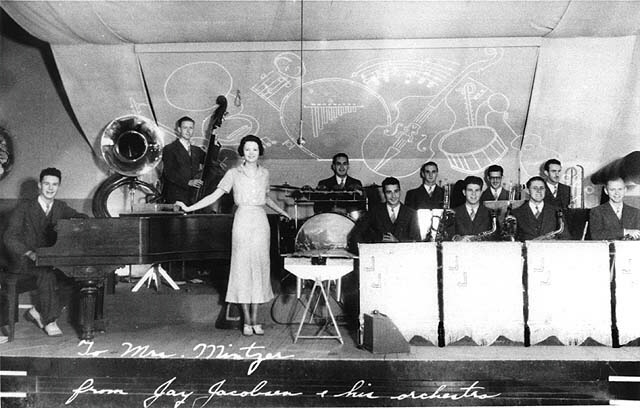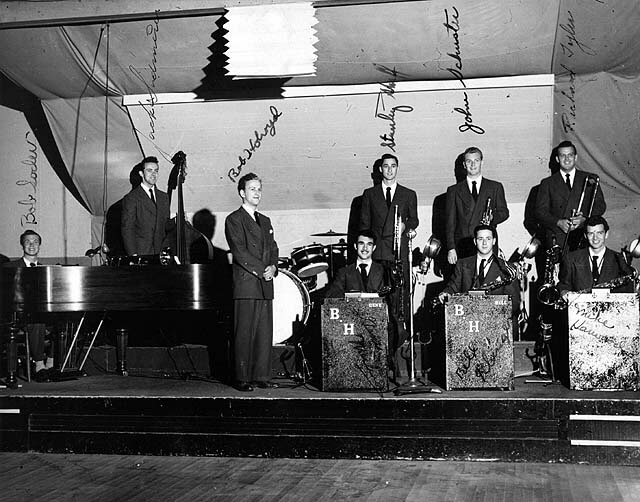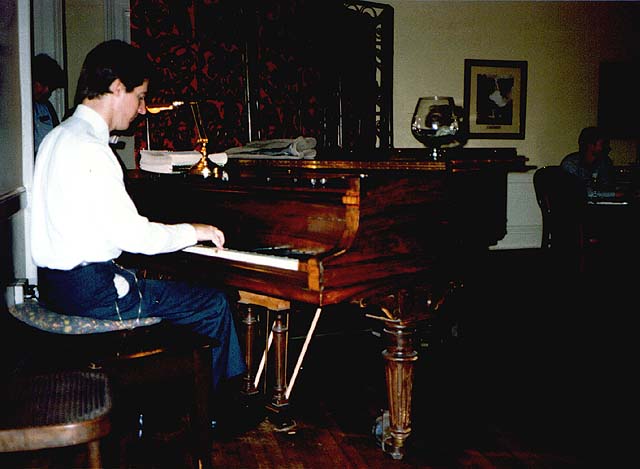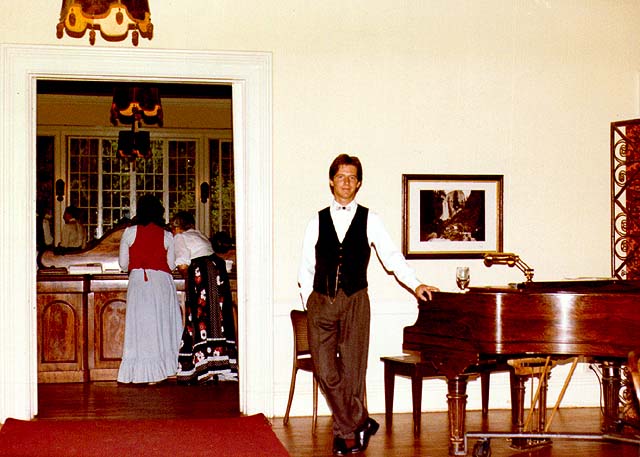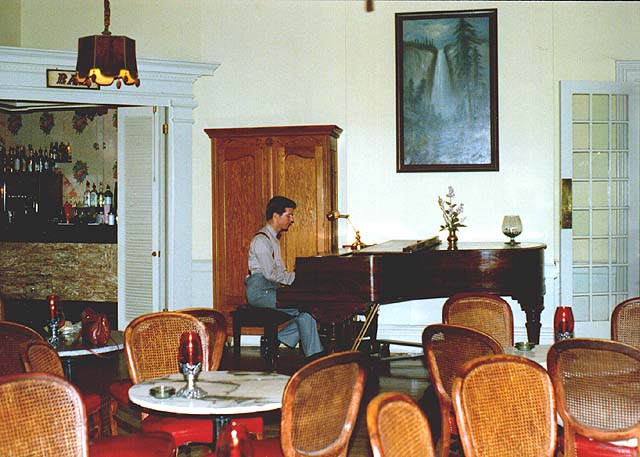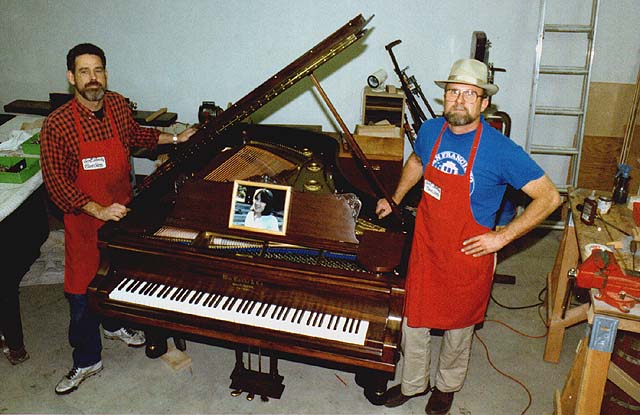|
History of the mysterious Wawona PianoNote: apparent variances in the photographs suggest that there may have been two pianos of the same make and model, or that the piano was damaged and/or modified. This remains a mystery and casts a shadow of doubt as to the true identity of the Wawona piano.
The Wawona Hotel piano was born in 1906 in Baltimore, Maryland, at the Wm. Knabe & Co. factory. How it came to be in Yosemite is, so far, a mystery. The Knabe in the above photograph,
taken on the Camp Curry Dance Pavilion stage, appears to be the same
Knabe as the one currently at Wawona, except for the apparently
horizontal surface at the right side of the keyboard (consistent with
other photographs of the piano in the Pavilion). Camp Curry was founded in
1899 as a less expensive alternative to hotels in Yosemite Valley; David
and Jennie Curry's tent-cabins continue to serve thousands of guests
every year. In reference to David Curry's booming voice, and a nightly
ritual known as the Fire Fall, a news release from 1910 reported
"Every night they kindle a great campfire. The people gather about
it, and as it dies down, some impromptu entertainment starts, or the
whole camp overhears Mr. Curry's private conversations. And up on
Glacier point, three thousand feet above, they kindle another fire, and
as it dies down they throw it over the cliff. It makes a veritable
cataract of flame and sparks--a beautiful sight. Mr. Curry thanks them
at a distance of a mile." The "impromptu entertainment" soon
evolved into organized stage productions—musical variety shows that
would include classical music, comic and popular songs, skits, and
poetical readings. Early photographs of these productions show that they
were performed on the porch of the front office (now the Curry Lounge)
next to a good-sized bonfire, and later on at an outdoor amphitheater
stage. Photographs also show that Camp Curry had several pianos,
possibly including a second Knabe.
This photo comes from Gene Merlino (seated center, just
left of the mike stand), who played sax and sang for the Bob Holroyd Orchestra,
which performed at Camp Curry for one season in 1947. Merlino went on to have a
successful career as a studio vocalist, including performing the voice-over
singing for Franco Nero in the movie Camelot. The pianist, Bob Soder, went on to
found the first public school jazz band programs in the nation. Note the addition of wooden dowel-rods bracing the
pedal-lyre, indicating that the pedal assembly was wearing out, or worse, that
the piano might have been rolled off the edge of the stage. These unfinished
dowels were still in place when I started performing on the piano in 1983. According to Merlino, the piano was moved to the outdoor
amphitheater for musical programs there, including accompanying the singing of
"Indian Love Call" during the Firefall, and moved back to the dance
hall every night. While possible, it also seems possible that there were pianos
in both locations. In 1968, the Fire Fall was discontinued along with the
nightly musical programs and dances. It is believed that the Dance Pavilion
underwent conversion to guest rooms the same year. Also, in 1968, the Knabe was
in a storage room attached to the outdoor amphitheater. Dudley Kendall worked at
the Wawona Hotel that year as dining room manager. According to Kendall, a Camp Curry porter named Marvin
Mulder used to like to play Beethoven on the Knabe piano when it was at the
Curry amphitheater. Mulder brought it to Kendall’s attention that the
neglected piano was being damaged by rainwater leaking in through the roof of
the storage room. Kendall convinced Wawona Hotel manager Bill Wismer that
the piano should be moved to Wawona. In July, 1968, Kendall enlisted the help of
locals Steve Attardo, John Simmons, and somebody named Sid (last name to be
discovered), headed to Camp Curry, and loaded the Knabe on a manure truck
borrowed from the Curry horse stables. Driving the truck himself, Kendall
remembered a bewildering multitude of gears on the stick-shift; he told me “I
found a gear that worked, and stayed in the same gear for the entire trip to
Wawona.”
Here I am in 1983 in what then was called the
"bar" at the Wawona Hotel. This was my first year on the job; I
started on May 25th. Note those back braces shown in the previous picture are
still on the pedal lyre. It was here that the piano sat from 1968 to 1984,
played on by casual passers-by, guests, amateurs, professionals. Dudley Kendall,
the dining-room manager, played on it fairly regularly in 1968. I once met a
lady who worked in some other job at Wawona, but played the piano for tips and
meals for a time. Bob Bradford and other ragtime piano players from Los Angeles
would often drop in and jam. Finally, the upper management of the Yosemite Park
& Curry Co. decided it was time to employ a full-time professional musician,
and I got the job.
During the winter of 1986-87, the upstairs rooms in the
main hotel building were renovated. Formerly used as employee housing (I lived
up there for four seasons), the added guest capacity caused managers to decide
that the "bar" should be returned to its original function as a dining
room, and so it was renamed "the petite dining room." The piano (after
some discussion of moving it into the main dining room) was moved out into what
was then called the "card room." As it turns out, the piano was moved to the same room
where Estella Washburn had played her upright piano in 1885; thus, one of the
Wawona's oldest musical traditions has been restored in a round-about way. The
image above is a watercolor painting by my wife, Diane Detrick Bopp. |

